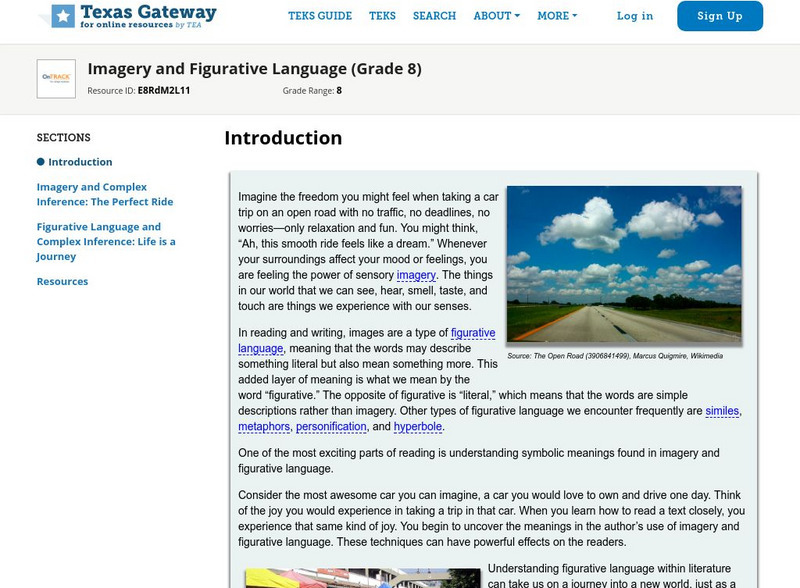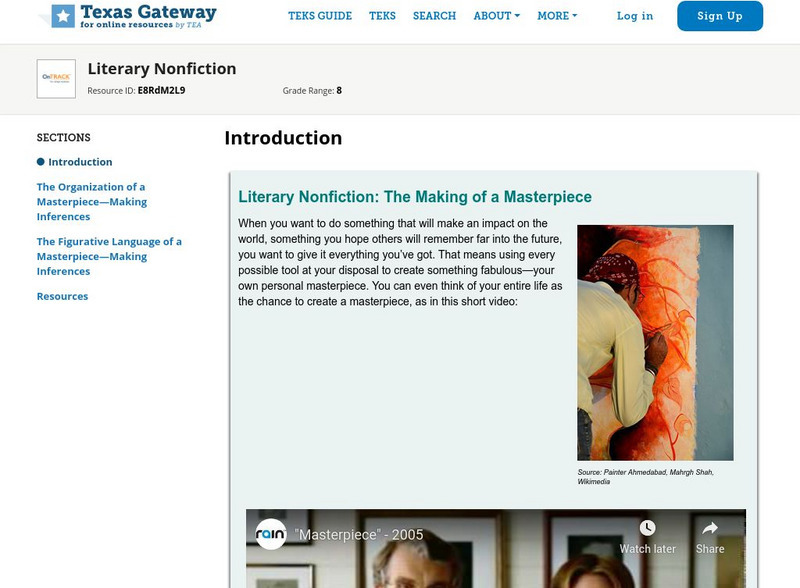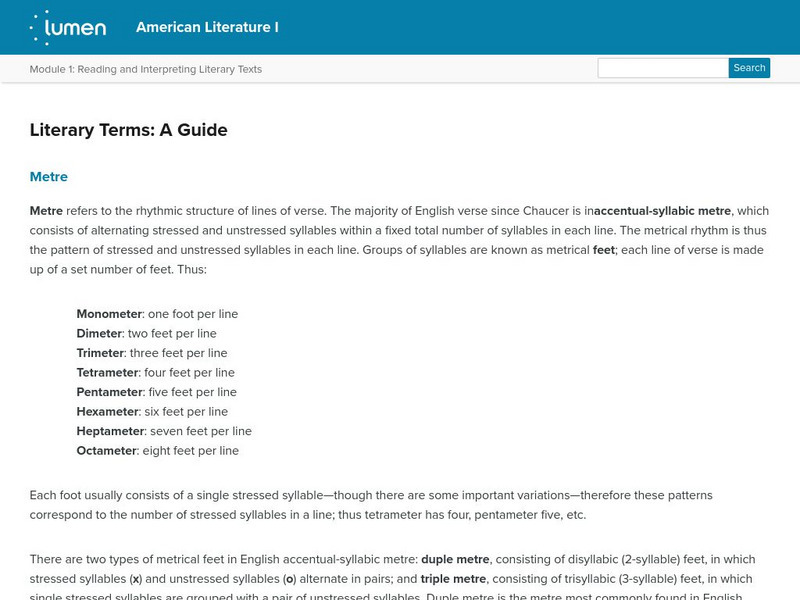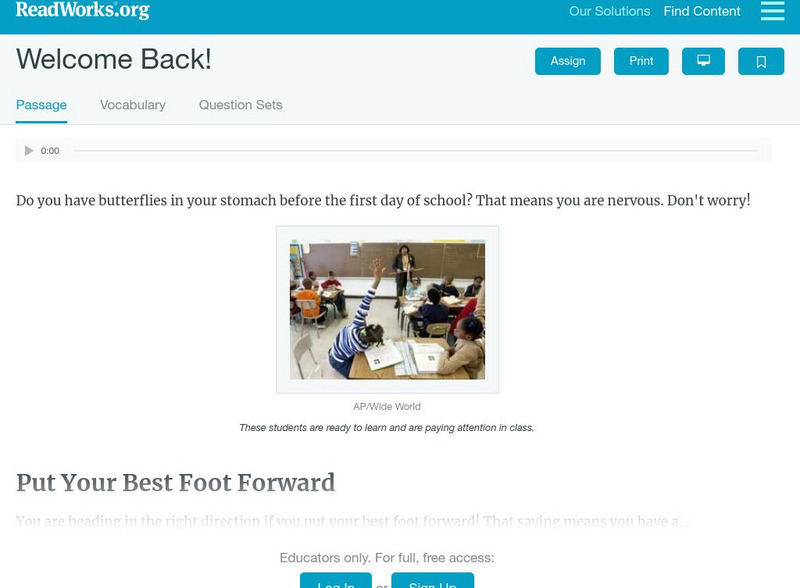National Endowment for the Humanities
Neh: Edsit Ement: Their Eyes Were Watching God: Folk Speech, Figurative Language
For this lesson plan, students will consider Their Eyes Were Watching God: Folk Speech and Figurative Language. Worksheets and other supporting materials can be found under the Resources tab. This lesson provides students with an...
E Reading Worksheets
E Reading Worksheets: Figurative Language: Shakespeare
This learning module provides remediation and extra practice with identifying figurative language techniques found in excerpts written by William Shakespeare. A worksheet is available to help reinforce the concept of figurative language...
E Reading Worksheets
E Reading Worksheets: Figurative Language Worksheets
This learning module provides remediation and extra practice with identifying different types of figurative language. Reinforcement is provided through the worksheets, quizzes, video game links, and online sites for the following types...
E Reading Worksheets
E Reading Worksheets: Figurative Language Activities
Numerous activities, games, quizzes, lessons, and PowerPoint presentations are provided for the topic of "figurative language" in writing. Students will have numerous exposures to examples. Students will also be able to practice...
Sophia Learning
Sophia: Writing Narratives
Notes, a PowerPoint presentation, two videos, a song, an exercise, and a game help students to understand how to write a narrative. Elements of a narrative as well as the use of figurative language and sensory images are introduced and...
Texas Education Agency
Texas Gateway: Imagery and Figurative Language (Grade 8)
Make complex inferences and use textual evidence such as imagery and figurative language to support understanding.
Texas Education Agency
Texas Gateway: Importance of Figurative Language: Practice 3 (English I Reading)
Read a text and understand how the figurative language of a literary work contributes to its historical and cultural setting.
Texas Education Agency
Texas Gateway: Imagery: Simile and Metaphor (English I Reading)
[Accessible by TX Educators. Free Registration/Login Required] Identify the similes and metaphors in a text and evaluate their importance to the meaning of the text. RL.9-10.5 text structure effects
Texas Education Agency
Texas Gateway: Literary Nonfiction
Learn how to analyze literary nonfiction, particularly speeches, by making inferences and drawing conclusions based on evidence in the text.
Other
Travis Unified School District: Figurative Language Terms in Julius Caesar [Pdf]
A one-page chart listing figurative language terms used in The Tragedy of Julius Caesar, along with definitions and examples.
Lumen Learning
Lumen: Reading and Interpreting Literary Texts: Literary Terms: A Guide
This is a guide to poetic literary terms such as meter and an explanation of several types of meter, types of stanzas, types of rhyme, etc.
Read Works
Read Works: Monster of the North
[Free Registration/Login Required] An informational text about the skeleton of a plesiosaur, a giant sea monster, found by scientists near the North Pole. A question sheet is available to help students build skills in reading comprehension.
Read Works
Read Works: Wonderful Trees
[Free Registration/Login Required] A poem about trees by Arin Lapa. A question sheet is available to help students build skills in reading comprehension.
Texas Education Agency
Texas Gateway: Polish Tone, Style, and Figurative Language (English Ii Writing)
In this lesson, students will learn strategies for evaluating and revising the tone, style, and figurative language in an essay.
CommonLit
Common Lit: Eating Together
CommonLit.org is a wonderful resource to use in a Language Arts classroom. Each story, article or poem is accompanied by guided reading questions, assessment questions, and discussion questions. In addition, students can click on words...
CommonLit
Common Lit: Columbus
CommonLit.org is a wonderful resource to use in a Language Arts classroom. Each story, poem, or article is accompanied by guided reading questions, assessment questions, and discussion questions. In addition, students can click on words...
CommonLit
Common Lit: Blizzard
CommonLit.org is a wonderful resource to use in a Language Arts classroom. Each story, poem, or article is accompanied by guided reading questions, assessment questions, and discussion questions. In addition, students can click on words...
CommonLit
Common Lit: "What Love Isn't" by Yrsa Daley Ward
CommonLit.org is a wonderful resource to use in a Language Arts classroom. Each story or article is accompanied by guided reading questions, assessment questions, and discussion questions. In addition, students can click on words to see...
CommonLit
Common Lit: Egg
CommonLit.org is a wonderful resource to use in a Language Arts classroom. Each story, article or poem is accompanied by guided reading questions, assessment questions, and discussion questions. In addition, students can click on words...
Read Works
Read Works: Welcome Back!
[Free Registration/Login Required] This passage shares advice about how to make the first day of school a great one. This passage is a stand-alone curricular piece that reinforces essential reading skills and strategies and establishes...
Love To Know Media
Your Dictionary: Literary Terms Lesson Plan
This is a lesson plan for teaching the seven literary terms used in poetry: simile, metaphor, alliteration, imagery, hyperbole, personification, and onomatopoeia.
Love To Know Media
Your Dictionary: Literary Terms to Know in Seventh Grade
This site lists and briefly defines the literary terms 7th graders should know including types of writing, literary devices, sound devices, figurative language, and parts of a story,
Love To Know Media
Your Dictionary: Onomatopoeia Lesson Plans for 10th Graders
This site offers links to lesson plans and ideas for teaching Onomatopoeia to high school students.
Broward Education Foundation
Broward Education Foundation: The Arts and Crafts of Storytelling [Pdf]
In the Arts and Crafts of Storytelling, American folk heroes come to life, help students expand their vocabulary and increase knowledge of figurative language. Students identify figurative language like similes, idioms and hyperboles....
















